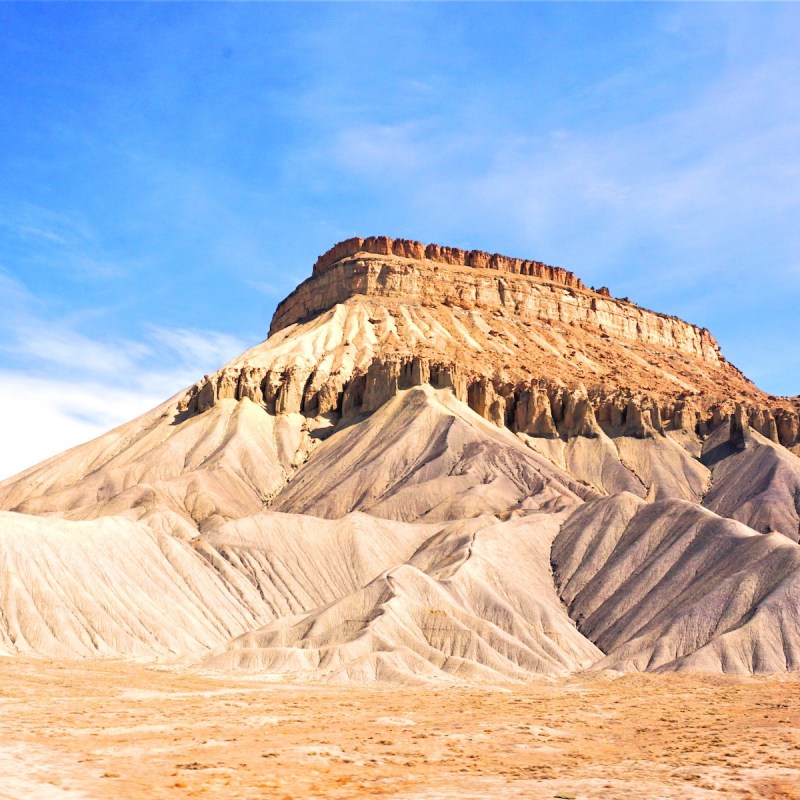
We pass through Grand Junction every time we visit our children in Denver, Colorado, and Boise, Idaho. This time, out of curiosity, we decided to stop and explore Grand Junction. Luckily, we found a resort near it in our timeshare directory. As we neared our destination coming west from Denver on I-70, imagine our amazement as steep cliffs began to rise all around us. When the receptionist greeted us, “Welcome to Grand Mesa, the largest flattop mountain in the world,” we realized we had a unique opportunity to experience a mountain with a flattop of over 500 square miles, rising to over 11,000 feet in elevation.
Videos by TravelAwaits

We didn’t know this when we booked our week’s stay, so exploring Grand Mesa became our top priority. We quickly found out that the best way to discover the mountain is to drive the Grand Mesa Scenic and Historic Byway (State Highway 65). It runs for more than 62 miles from the northern terminus in Mesa to the southern terminus near Cedaredge. The drive offered dramatic landscapes, several points of interest, spectacular views, and little towns. Here are the 10 reasons we now think of Grand Mesa as the true hidden gem in this part of Colorado.
1. The Land’s End Observatory
Driving the byway starting in Mesa, you will reach the Land’s End Road after about 15 minutes of driving. Go 10 miles on this half-paved and half-gravel road open only during summer. Don’t expect a futuristic edifice, though, because the Land’s End Observatory is really mountain cabins once fitted with the necessary equipment but closed since 2014. There is still a pit toilet and the stunning views of the national forest from the rim is well worth the detour.

2. Rustic Lodging Options
Not far from Land’s End Road you will find a larger and newer log cabin which we thought was the visitor center. It is the Grand Mesa Lodge operating under special-use permit from the Forest Service. Together with a restaurant and bar, there are 14 rustic cabins and a one-bedroom suite for rent. Boats of various types and sizes can be rented to enjoy the pristine waters of nearby Island Lake.
We stayed at the Powderhorn Mountain Resort, the popular group of lodging options in Mesa, and the ski area of the Grand Mesa. The Goldenwoods Condominium provided great value. Our spacious room had large closets. Billed as a one-bedroom unit, it actually sleeps six with an extra loft above and a sofa bed in the living room. There were also tiny homes, spread out beside our traditional lodge, as alternative lodging options.
Other lodging options include two Forest Service cabins, the Black Bear and Moose Manor cabins, built in the 1930s that are available for reservation throughout summer. In addition, reservations can be made at Cobbett Lake Campground but all the other campgrounds are first-come, first-served.

3. Over 300 Stream-Fed Alpine Lakes
The flattop mountain lies mostly within the Grand Mesa National Forest and boasts more than 300 stream-fed alpine lakes. During early summer, the expansive meadows around the lakes are blessed with wildflowers. At one of the lakes where we stopped to take some photos, I chanced upon some ladies happily engrossed in painting the beautiful scene. As a beginner in this art form, I wished I could join them. At another lake, there was a lone man in his kayak seeming to thoroughly enjoy the cool quiet summer day, fishing the trout-stocked lake.

4. Classic Hiking Trails
For a classic Grand Mesa adventure, if you have the time, there is the Crag Crest Trail, a 10.3-mile loop and designated National Recreation Trail running along the Grand Mesa spine. It has views of up to 100 miles on a clear day. It can be accessed from either trailhead — near Scenic Byway mile marker 27 on the west side or at the Crag Crest Campground to the east. Near the Forest Service cabins is the heavily-trafficked 4-mile Lost Lake Trail bordering the narrow, emerald-colored Lost Lake.
5. Fun Festivals
We were too early for the Grand Mesa Moose Day which was held this year on July 31. This festival, in appreciation of the hundreds of moose that thrive in the forest, draws more than a thousand visitors every year. The end of September also marks Color Sunday, with activities at many stops all along the byway to celebrate Grand Mesa’s spectacular fall foliage. The festivals are fun times but if you prefer the quiet serene mountain life the area offers, plan your visit outside of these two crowded weekends.

6. The Grand Mesa Visitor Center
Forty minutes from Powderhorn Resort and nearer the southern terminus of Cedaredge, is the Grand Mesa Visitor Center. This is a facility of the Forest Service under the U.S. Department of Agriculture and not of the National Park Service of the Department of Interior that most of us are more familiar with. Center staff may lead you on nature hikes but there is also a “Discovery Trail #745” that has interpretive exhibits. Experts conduct presentations on wildlife, wildflowers, birds, mushrooms, and moose. You might also enjoy the good-sized gift shop nicely stocked with mountain souvenirs. The center is where you can also make many connections to hiking trails, and Baron Lake sits just beside it.

7. The Small Town Of Cedaredge
At the lower elevation of 6,000 feet, the quaint town of Cedaredge will greet you at the southern terminus of the byway between Mile Markers 9 and 12. Thirty percent of the 2,400 residents are 65 years of age and older, enjoying the mild climate, low taxes, outdoor recreational opportunities, health care facilities, and cultural activities. Beyond those available on Grand Mesa, there were also numerous recreational opportunities in town: a park, playground, tennis/pickleball courts, “gnarly dude” skatepark, community garden, golf club, rodeo arena, multiplex baseball and soccer facilities, fairgrounds, recreation centers, and swimming pools.

8. The Small Town Of Mesa
Even smaller, with only about 600 residents, is the small unincorporated community of Mesa which hosts the ski area at the northern terminus. The Powderhorn Resort and other resorts in the area sit at more than 8,000 feet elevation and stay 20 degrees cooler than the sometimes triple digits down in the valley. There is a ski lift platform in the middle of the resort and breathtaking vistas greet you after riding the lifts to the top. We also found an interesting monument, the first one of its kind erected in the USA, the American Servicewomen Memorial Park in Collbran, Colorado, just 15 minutes away.
9. The Small Town Of Palisade
The town of Mesa is so small that, when we needed staples or supplies, we had to drive to the town of Palisade down the valley. Even if the trip took 30 minutes each way, every visit was a pleasure. Named for the cliffs near the town site, Palisade is best known for its peach orchards and wine vineyards. As a matter of fact, it is called the “Peach Capital of the World.” Within its population of 2,700 is a thriving local creative arts community. Thus the town hosts many lively music festivals and farmers markets.

10. Grand Junction And The Colorado National Monument
Our original reason for being in the area was to explore Grand Junction. So we dedicated a day to the city; the trip took 45 minutes each way. At about 4,500 feet elevation, 60,000 people make it home. Mt. Garfield looms over the city, providing many striking vistas. We were even fortunate to find a very affordable authentic Nepalese restaurant called Namaste.
After lunch, we took a peek at the Colorado National Monument just 10 minutes away. There are monoliths that tower over vast plateaus and panoramas, revealing spectacular red rocks along the 23-mile Rim Rock Drive. We loved the Coke Oven’s viewpoint best and we hiked Otto’s Trail, a short 0.7 mile round trip, dropping about 200 feet in elevation to an overlook featuring Wedding Canyon, Monument Canyon, Pipe Organ, and Independence Monument. And you can believe the website’s promise: “You will encounter bighorn sheep.” Three of them cavorted and played in front of us on the way out of the national monument.
Pro Tip: There are two other day trips from Grand Mesa if you can stay longer. The North Rim of the Black Canyon of the Gunnison National Park (the more remote entrance) is only about 60 minutes south of Cedaredge. Even Glenwood Springs is just 60 minutes east of Mesa, and the drive there is quite scenic if you take the backroads from Mesa rather than I-70.
Grand Junction is one of many outstanding Colorado towns:
